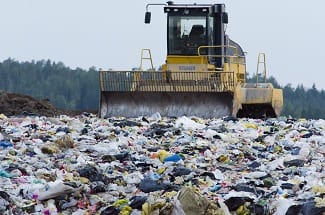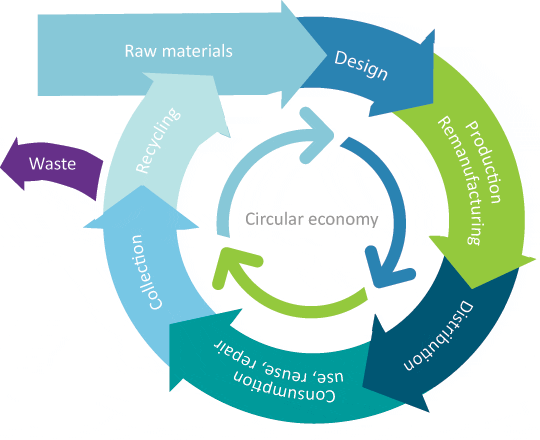Addressing Food and Commercial Waste Practices in Ontario

Waste has been a growing concern across Ontario for over 40 years. Despite the desire to reduce our garbage output, Ontarian’s generate over 12 million tonnes of food and commercial waste per year. To mitigate this issue, the government has focused its efforts on “waste diversion”, which helps prevent waste from ending up in landfills or incinerators. In addition, a strong focus has been placed on the importance of reducing and reutilizing disposable materials.
Reduce, reuse, recycle; a common concept that was created along with the implementation of Ontario’s ‘Blue Box’. However, despite the province’s efforts to address food and commercial waste practices, Ontarians continue to dispose of more waste per capita than any other population on earth.
Our waste management mandate focuses on the following:
- Reducing the amount of waste that we generate;
- Reusing what may be considered ‘trash’ to avoid disposing of it; and
- Recycling waste to create new goods that can be sold again.
However, our focus has shifted away from the first two concepts and most residents and businesses in Ontario only focus on the concept of recycling. Though beneficial, recycling only diverts approximately 8% of waste from landfills. In 2016, the Government of Ontario introduced the Waste-Free Ontario Act, to address waste diversion and potential environmental consequences.
Ontario’s Growing Food and Commercial Waste Issue
In Ontario, residents, businesses, and tourists collectively generate over 12 million tonnes of waste per year. To dispose of this waste, the province depends on two processes, (1) landfilling and (2) incineration. Both practices lead to negative environmental outcomes; the process of landfilling releases harmful toxins into soil and groundwater, and incineration generates toxic air pollutants. Yet recent statistics indicate that more than 75% of annual waste is still being transported to landfills or incineration facilities.
Landfilling generates and releases methane, which is a toxic greenhouse gas that has a significant impact on climate change. 15% of Ontario’s emissions are produced through annual waste disposal.
So why is it that Ontarian’s create so much waste? The main contributor is how much we consume as a society – we simply have too much “stuff”. The second issue is accessibility to cheap commodities that are only intended to have a short lifespan. For example, consumer behaviour shows that instead of purchasing a cloth that can be reused multiple times, we are more likely to purchase a pack of disposal wipes instead. Today, we have access to thousands of products that are strictly designed for one-time use. The “out with the old, in with the new” mentality dramatically increases the amount of waste we produce.
Solving Ontario’s Food and Commercial Waste Challenges
Every year, Ontario has less landfill space and less capacity for waste disposal, however the amount of waste we create continues to increase. For nearly 40 years, Ontario has tried to divert the amount of waste transferred to landfills through recycling. However, as a society we have been unsuccessful at reducing or reusing the waste we create.
To help address the growing issue, the government introduced the Waste-Free Ontario Act in 2016 and the concept of a circular economy.

What a Circular Economy?
In a circular economy, resources would not be used once and then discarded as trash. Instead, the concept aims to promote less use of resources, more sharing, and more repairing. A circular economy ensures resources are used efficiently and repeatedly.
The following list includes some of the top recommendations made by the Environmental Commissioner of Ontario:
- Bring attention to reducing and reusing consumer goods before disposing of them;
- Implement a disposal ban on food waste;
- Create products that are more durable, easier to repair, and can be recycled;
- Develop enforceable recycling standards that better protect the environment; and
- Establish ‘zero-waste’ grassroots across the province.
Ontario Government Funding Supports Environment Solutions
Businesses in Ontario have an opportunity to become global leaders of the Circular Economy. Approximately 90% of global waste takes place during resource extraction, factory production, and the transportation of consumer goods. Businesses can have a significant impact on global sustainability by shifting their focus to develop goods that are more durable, easier to repair, can be shared among consumers, and contain less packaging.
To support the concept of a circular economy business owners in Ontario can leverage government funding to support strategic initiatives that have positive environmental impacts. Depending on the type of project a business is conducting, there may be funding available to help accelerate timelines and reduce project costs.
To help address waste reduction in Ontario, businesses can consider the following funding programs:
Greenbelt Fund: Ontario Agriculture Grants
The Greenbelt Fund: Local Food Investment Fund provides agriculture grants to increase consumers’ awareness, demand, and consumption of Ontario-based foods and beverages. The program supports projects that improve market access to individual farmers or food processors, increase the amount of food consumed by Ontario’s private sector, and enhance food literacy among public consumers.
The Greenbelt Fund provides up to 50% coverage of project expenses to implement initiatives benefiting local food companies.
By sourcing local foods and beverages, businesses can reduce their carbon footprint and the amount of waste generated and dumped back into the environment. For example, locally sourced products require less transportation time which in-turn results in less toxic emissions.
IRAP Research and Development Grants
The Industrial Research Assistance Program (IRAP) provides Canadian research and development grants to businesses developing and implementing internal process improvements. The program has two funding streams, including Accelerated Review Process and Mid-Size Projects. IRAP ARP research grants can be used to help solve an internal technical challenge with a focus on adopting technology and processing enhancements. IRAP Mid-Size Project grants support projects focused on overcoming technical challenges through the development and commercialization of innovative products.
Depending on the program stream, IRAP provides up to 65-80% coverage offset internal labour expenses to a maximum $50,000-$500,000 in research grants.
For example, research funding can help businesses address internal challenges to optimize their product output and reduce waste by identifying defects during production and processing activities.
CME SMART Green Fund
Manufacturers can access the CME SMART Green Fund to accelerate the adoption of innovative technologies that improve a company’s productivity and energy efficiency. Ideal projects focus on the reduction or elimination of greenhouse gas emissions, while improving the company’s productivity.
The program provides manufacturers with up to $500,000 per facility to a maximum $1.5 million in funding for upgrades to up to five facilities.
By improving manufacturing facilities, businesses can improve their energy efficiency, while also reducing the amount of GHG emissions that are created during production activities. For example, replacing old boilers with biogas units that will generate less GHGs during product production.
Explore More Ontario Small Business Funding Options
Understanding the Canadian Government Funding Landscape
There are various government funding options that small and medium-sized businesses can explore. Business owners and executives can get started by access information that will help explain the funding landscape and which types of projects are best suited for government grants and loans.
Download Mentor Works’ Canadian Small Business Funding Guide to learn more about funding opportunities for your company.

